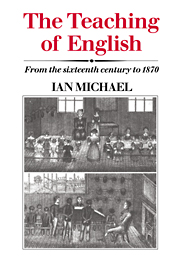Book contents
- Frontmatter
- Contents
- List of tables
- Preface
- 1 The enquiry: scope, method, texts
- 2 Reading, spelling, pronunciation: the elements
- 3 Reading, spelling, pronunciation: the skills
- 4 Interpretation: literature presented
- 5 Interpretation: literature taught
- 6 Expression and performance
- 7 Linguistic control
- 8 English: the development of a subject
- Abbreviations
- Bibliography 1
- Bibliography 2
- Bibliography 3
- Bibliography 4
- Index
8 - English: the development of a subject
Published online by Cambridge University Press: 05 June 2012
- Frontmatter
- Contents
- List of tables
- Preface
- 1 The enquiry: scope, method, texts
- 2 Reading, spelling, pronunciation: the elements
- 3 Reading, spelling, pronunciation: the skills
- 4 Interpretation: literature presented
- 5 Interpretation: literature taught
- 6 Expression and performance
- 7 Linguistic control
- 8 English: the development of a subject
- Abbreviations
- Bibliography 1
- Bibliography 2
- Bibliography 3
- Bibliography 4
- Index
Summary
The term ‘English’
One of the purposes of this enquiry was to examine the often made statement that there was little or no teaching of English before the final decades of the nineteenth century. When was English first taught? The preceding chapters provide the materials for an answer, but they show also that the question should be expressed differently, and that it is necessary to consider the term ‘English’ itself: a more ambiguous one than might be expected.
Francis Clement was quoted above (p. 5) as addressing ‘the English teacher’ in 1587. Although he was writing for teachers of reading and spelling, the expression he uses sounds as if he thought that there was a subject called ‘English’, however narrow in scope. It is reasonable, and probably accurate, to interpret him in this way; but there is a slight doubt. It is possible that what Clement thought of his readers as teaching was not a subject, but a language: English, not Latin. He may have been using ‘English teacher’ in the sense of Coote's ‘Schoolmaisters of the English Tongue’ (1596, A2). But such doubts are overrefined. Neither Clement nor Coote was concerned with English as contrasted with, or analogous to, any other language. They were, and were writing for, in Mulcaster's words, ‘such people as teach children to read and write English’ (1582, p. 53). At this date basic facility in the language was the subject.
- Type
- Chapter
- Information
- The Teaching of EnglishFrom the Sixteenth Century to 1870, pp. 372 - 385Publisher: Cambridge University PressPrint publication year: 1987

